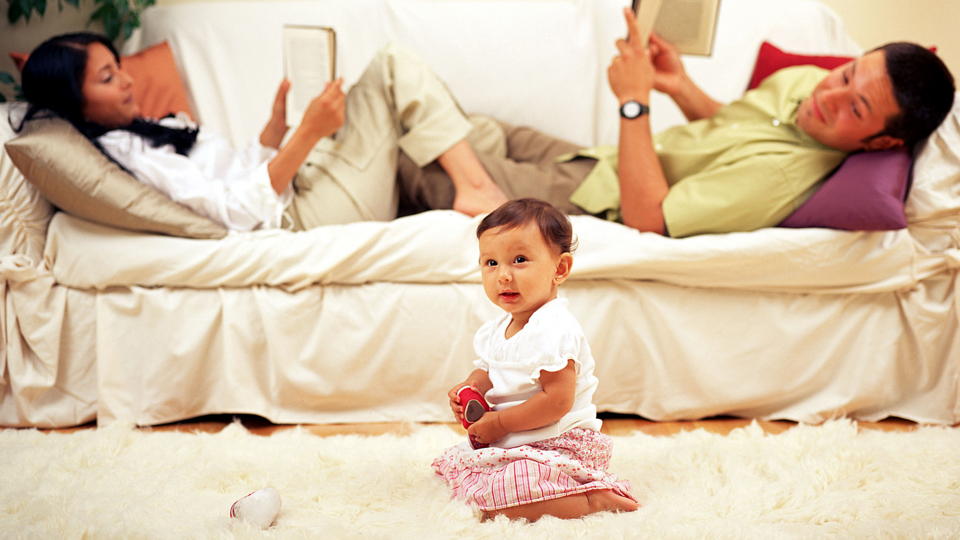Separating mommy for "me" time

We love our babies, but a little independent play is good for all involved.
We love our babies and enjoy cuddling them, reading to them, and wearing them on grand adventures. And still, every once in a while, it is nice to be able to put the kid down and have a (still warm!) cup of tea, read a book (without pictures!), or wash the dishes.
And it is not a selfish desire at all—when a baby is ready to play independently, he gets a big confidence boost and develops his imagination by playing alone. Some tips to keep in mind when you are ready for the joys of independent play:
- Saftety first! Even if you do not plan on leaving the room, double check that baby cannot get into any trouble before you focus your attention elsewhere. Of course, the toys should be age-appropriate and safe for play. Remember that babies seem to develop the sudden urge to take a (sometimes literal) leap in gross motor skills when you least expect it and once they start moving, they are quicker than you might think!
- Wait for signs of readiness. If your baby can sit independently, he is better able to engage with his toys. If your child can focus on a toy for several minutes at a time, you can try gradually removing yourself from the immediate play area.
- As with all milestones, readiness will vary. My second baby has been quite content to play with his toys, his own feet, and anything else that happened to be around from very early on--certainly by about three months. However, my first child wanted all attention on her as an infant. By a year, though, she was quite content to play for 20 minutes or more independently, and now that she is a preschooler she is happy to draw for hours. Do not fret if your baby still needs you nearby and try to enjoy this first year—it passes too quickly! You can gently nudge toward independent play but pushing a "high need" baby before he is ready may actually backfire.
- Set up a defined "play space." Of course, play can, and should, happen anywhere. Babies, though, thrive on predictability. If you have a special, plain, comfortable "play mat," your baby will know what to expect when you roll it out and will likely even look forward to this time. Try to make this play space portable so you can set it up anywhere in the house.
- Initially, choose times of day when baby is well-rested, fed, and alert and happy. Once your baby has positive associations with independent play (instead of, "Oh, no! Why is Mommy trying to get away from me?"), you will have a tool you can use throughout the day when you need it.
- Remove yourself from direct involvement in play slowly. First, stay where you are but do not initiate or lead the play. Then, take a step back but remain close. When your baby seems ready, you can focus on another task in the same room. Eventually you will even be able to go to a room nearby--just make sure you are in earshot!
- Keep the sessions short initially if your child seems reluctant and then gradually increase the time. A toddler who is still not playing independently may respond well to a kitchen timer: "You get to play with your trains for five minutes while Daddy goes over here to set the table. When the buzzer goes off, Daddy will come and play with you."
- Save a few "favorite" toys for independent play time (my kids both loved the LeapFrog Learn & Groove Musical Table) or rotate in new toys for a sense of novelty.
- Keep the play space relatively uncluttered and only put out a handful of toys. For an infant, this might be just one toy. For an older infant, you might provide a choice of two. Toddlers might appreciate a small box of several toys. Too many choices can be overwhelming for young children.
- Toddlers love to sort and match. Simple games like a muffin tin with a few dried beans and different shaped pasta will keep many toddlers occupied for longer than it takes to make dinner. A few other classics include tossing games (a bean bag or even a wadded up piece of paper) and safe splashing (playing at a sink or with a bowl of shallow water while an adult is in the same room).
- Demonstrate to your baby some possible ways to play with a toy but do not dictate. Your baby may initially not be sure how to play alone so a few ideas from mom or dad will spark discovery. Allow him to develop his own, outside of the instruction sheet, way of play to build his own self-esteem and to encourage independence.
Both independent play and playing together with a care taker are important parts of an infant or toddler's development. Give your baby lots of opportunities for both!











